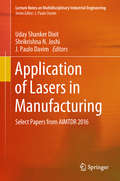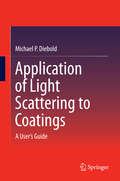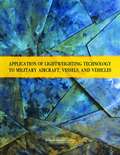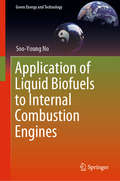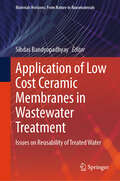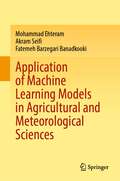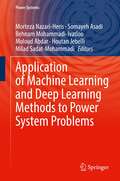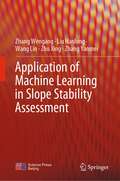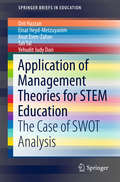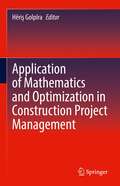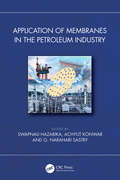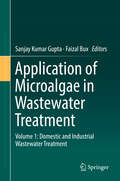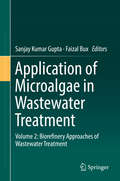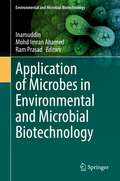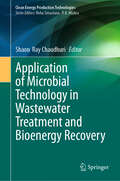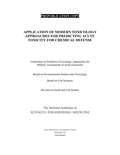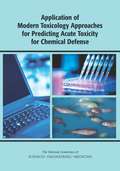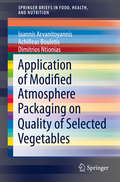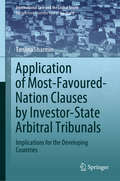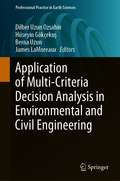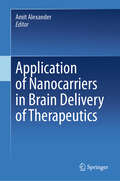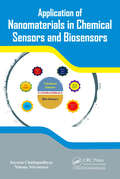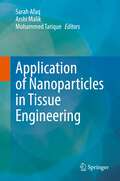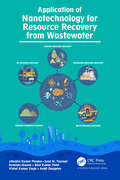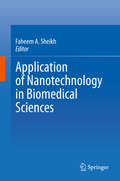- Table View
- List View
Application of Lasers in Manufacturing: Select Papers From Aimtdr 2016 (Lecture Notes on Multidisciplinary Industrial Engineering)
by J. Paulo Davim Uday Shanker Dixit Shrikrishna N. JoshiThis book mainly addresses the applications of lasers in the manufacture of various industrial components. The technologies presented here have scopes of application ranging from the macro to meso and micro level of components and features. This book includes chapters on the basic and advanced applications of lasers in the manufacturing domain. They present theoretical and practical aspects of laser technology for various applications such as laser-based machining, micro-scribing, texturing, machining of micro-sized channels; laser welding; laser-based correction of sheet metal, i.e. straightening; laser forming; and laser technology for 3-D printing. Lasers have various applications such as the production of powerful lights for illumination or decoration; measurement of velocity (transportation) and length; interferometry; printing; recording; communication; bio-medical instrumentation and pollution detection. A significant body of literature is available on the physics of lasers and types of lasers. However it has been noted there are a few books published on the “applications of lasers in manufacturing domain,” a gap that this book remedies. Gathering contributions by leading engineers and academicians in this area, it offers a valuable source of information for young scientists and research students.
Application of Light Scattering to Coatings: A User’s Guide
by Michael P. DieboldThe book begins with the fundamentals of light scattering, first by individual particles, then by small groups of particles, and finally by the trillions of particles present in a real-life paint film. From there, Dr. Diebold focuses on application of these fundamentals to paint formulation. The scope includes both theory and practice with an emphasis on application (from both performance and cost standpoints). The book gives a clear understanding of light scattering principles and application of these principles to paint formulation (with a focus on TiO2 - the strongest scattering material available to paint formulators). The reader will be in a position to formulate and reformulate paints for maximum cost effectiveness. Application of Light Scattering to Coatings: A Users Guide is ideal for a range of professions working in paint formulation and manufacturing. This book also: Distills difficult theories (light scattering, paint formulation) into easy-to-understand concepts Adopts a qualitative perspective, with minimal use of complex equations, making key scientific concepts accessible to all paint formulators without a prerequisite of higher mathematics Offers an accessible resource for formulators new to the field while maintaining a high degree of relevance to experienced coating formulators Discusses the interplay between resin, TiO2 pigments, and paint extenders with regard to paint performance and cost Presents an unbiased assessment of opacifying potential of TiO2 alternatives Outlines strategies for minimizing overall costs of paints.
Application of Lightweighting Technology to Military Vehicles, Vessels, and Aircraft
by National Research Council Division on Engineering and Physical Sciences National Materials and Manufacturing Board Committee on Benchmarking the Technology and Application of LightweightingLightweighting is a concept well known to structural designers and engineers in all applications areas, from laptops to bicycles to automobiles to buildings and airplanes. Reducing the weight of structures can provide many advantages, including increased energy efficiency, better design, improved usability, and better coupling with new, multifunctional features. While lightweighting is a challenge in commercial structures, the special demands of military vehicles for survivability, maneuverability and transportability significantly stress the already complex process. Application of Lightweighting Technology to Military Vehicles, Vessels, and Aircraft assesses the current state of lightweighting implementation in land, sea, and air vehicles and recommends ways to improve the use of lightweight materials and solutions. This book considers both lightweight materials and lightweight design; the availability of lightweight materials from domestic manufacturers; and the performance of lightweight materials and their manufacturing technologies. It also considers the "trade space"--that is, the effect that use of lightweight materials or technologies can have on the performance and function of all vehicle systems and components. This book also discusses manufacturing capabilities and affordable manufacturing technology to facilitate lightweighting. Application of Lightweighting Technology to Military Vehicles, Vessels, and Aircraft will be of interest to the military, manufacturers and designers of military equipment, and decision makers.
Application of Liquid Biofuels to Internal Combustion Engines (Green Energy and Technology)
by Soo-Young NoThis book provides a comprehensive overview of the application of liquid biofuels to internal combustion (IC) engines. Biofuels are one of the most promising renewable and sustainable energy sources. Particularly, liquid biofuels obtained from biomass could become a valid alternative to the use of fossil fuels in the light of increasingly stringent environmental constraints. In this book, the discussion is limited to liquid biofuels obtained from triglycerides and lignocellulose among the many different kinds of biomass. Several liquid biofuels from triglycerides, straight vegetable oil, biodiesel produced from inedible vegetable oil, hydrotreated vegetable oil, and pyrolytic oil have been selected for discussion, as well as biofuels from lignocellulose bio-oil, alcohols such as methanol, ethanol and butanol, and biomass-to-liquids diesel. This book includes three chapters on the application of methanol, ethanol and butanol to advanced compression ignition (CI) engines such as LTC, HCCI, RCCI and DF modes. Further, the application of other higher alcohols and other drop-in fuels such as DMF, MF, MTHF, and GVL are also discussed. The book will be a valuable resource for graduate students, researchers and engine designers who are interested in the application of alcohols and other biofuels in advanced CI engines, and also useful for alternative energy planners selecting biofuels for CI engines in the future.
Application of Low Cost Ceramic Membranes in Wastewater Treatment: Issues on Reusability of Treated Water (Materials Horizons: From Nature to Nanomaterials)
by Sibdas BandyopadhyayThis book reviews the status of developing tailor-made low-cost membranes and membrane-based separation processes for applications in wastewater treatment. It also presents an overview of industry-specific case studies upholding the waste-to-resource strategy for utilization of low-cost ceramic membranes in industrial wastewater treatment. This book highlights methods, results, and examples demonstrating that low-cost ceramic membranes possess similar features and advantages comparable to the commercially available ceramic membranes, thereby minimizing the prohibitive cost of their usage in wastewater treatment. Thus, the readers who are looking for more economical alternatives for wastewater treatment can be introduced with the cheaper membrane materials. It also discusses the selection and method of application of such membranes in the treatment processes. This book can serve as a valuable reference for researchers and professionals interested in wastewater treatment and allied fields.
Application of Machine Learning Models in Agricultural and Meteorological Sciences
by Mohammad Ehteram Akram Seifi Fatemeh Barzegari BanadkookiThis book is a comprehensive guide for agricultural and meteorological predictions. It presents advanced models for predicting target variables. The different details and conceptions in the modelling process are explained in this book. The models of the current book help better agriculture and irrigation management. The models of the current book are valuable for meteorological organizations. Meteorological and agricultural variables can be accurately estimated with this book's advanced models. Modelers, researchers, farmers, students, and scholars can use the new optimization algorithms and evolutionary machine learning to better plan and manage agriculture fields. Water companies and universities can use this book to develop agricultural and meteorological sciences. The details of the modeling process are explained in this book for modelers. Also this book introduces new and advanced models for predicting hydrological variables. Predicting hydrological variables help water resource planning and management. These models can monitor droughts to avoid water shortage. And this contents can be related to SDG6, clean water and sanitation. The book explains how modelers use evolutionary algorithms to develop machine learning models. The book presents the uncertainty concept in the modeling process. New methods are presented for comparing machine learning models in this book. Models presented in this book can be applied in different fields. Effective strategies are presented for agricultural and water management. The models presented in the book can be applied worldwide and used in any region of the world. The models of the current books are new and advanced. Also, the new optimization algorithms of the current book can be used for solving different and complex problems. This book can be used as a comprehensive handbook in the agricultural and meteorological sciences. This book explains the different levels of the modeling process for scholars.
Application of Machine Learning and Deep Learning Methods to Power System Problems (Power Systems)
by Behnam Mohammadi-Ivatloo Morteza Nazari-Heris Somayeh Asadi Moloud Abdar Houtan Jebelli Milad Sadat-MohammadiThis book evaluates the role of innovative machine learning and deep learning methods in dealing with power system issues, concentrating on recent developments and advances that improve planning, operation, and control of power systems. Cutting-edge case studies from around the world consider prediction, classification, clustering, and fault/event detection in power systems, providing effective and promising solutions for many novel challenges faced by power system operators. Written by leading experts, the book will be an ideal resource for researchers and engineers working in the electrical power engineering and power system planning communities, as well as students in advanced graduate-level courses.
Application of Machine Learning in Slope Stability Assessment
by Zhang Wengang Liu Hanlong Wang Lin Zhu Xing Zhang YanmeiThis book focuses on the application of machine learning in slope stability assessment. The contents include: overview of machine learning approaches, the mainstream smart in-situ monitoring techniques, the applications of the main machine learning algorithms, including the supervised learning, unsupervised learning, semi- supervised learning, reinforcement learning, deep learning, ensemble learning, etc., in slope engineering and landslide prevention, introduction of the smart in-situ monitoring and slope stability assessment based on two well-documented case histories, the prediction of slope stability using ensemble learning techniques, the application of Long Short-Term Memory Neural Network and Prophet Algorithm in Slope Displacement Prediction, displacement prediction of Jiuxianping landslide using gated recurrent unit (GRU) networks, seismic stability analysis of slopes subjected to water level changes using gradient boosting algorithms, efficient reliability analysis of slopes in spatially variable soils using XGBoost, efficient time-variant reliability analysis of Bazimen landslide in the Three Gorges Reservoir Area using XGBoost and LightGBM algorithms, as well as the future work recommendation.The authors also provided their own thoughts learnt from these applications as well as work ongoing and future recommendations.
Application of Management Theories for STEM Education: The Case of SWOT Analysis (SpringerBriefs in Education)
by Orit Hazzan Einat Heyd-Metzuyanim Yehudit Judy Dori Anat Even-Zahav Tali TalThis work describes the application of management theories in STEM (Science, Technology, Engineering and Mathematics) education systems. Two chapters examine STEM education on the K-12 national level and one chapter focuses on the higher education institutional level. All chapters are based on comprehensive research. Thus, it will appeal to teachers, school principals, researchers, graduate students, government policymakers, and all practitioners who care about STEM education in schools, academia and government. In each chapter, SWOT (Strengths, Weaknesses, Opportunities, and Threats) analysis is used as a managerial strategic tool for the examination of factors that focus either on internal circumstances (strengths and weaknesses), or external ones (opportunities and threats).
Application of Mathematics and Optimization in Construction Project Management
by Hêriş GolpîraThis book provides a broad overview of project and project management principles, processes, and success/failure factors. It also provides a state of the art of applications of the project management concepts, especially in the field of construction projects, based on the Project Management Body of Knowledge (PMBOK). The slate of geographically and professionally diverse authors illustrates project management as a multidisciplinary undertaking that integrates renewable and non-renewable resources in a systematic process to achieve project goals. The book describes assessment based on technical and operational goals and meeting schedules and budgets.
Application of Membranes in the Petroleum Industry
by Swapnali Hazarika Achyut Konwar G. Narahari SastryThis book focuses on the advantageous features of membrane technology in petroleum industries, with an emphasis on membrane materials and the application of membranes in the separation of olefin–paraffin, oil–water, aliphatic–aromatics, heavy metals, etc., along with other applications like waste management, sulphur emission, enhanced oil recovery and so forth. It also discusses the design and development of membranes from novel materials, the challenges of new materials for membrane applications, membrane-based processes and the application of novel membrane-based processes in the petroleum industry.Features: Addresses the fundamental applications of membranes in petroleum industrial separation processes Highlights the role of membrane technology in waste management in petroleum industries Includes novel engineered membrane materials Discusses methods of extracting valuable substances from produced water and membrane fouling control Emphasises solving industrial problems pertinent to membrane usage This book is aimed at researchers and graduate students in chemical and petroleum engineering and membrane technology.
Application of Microalgae in Wastewater Treatment: Volume 1: Domestic and Industrial Wastewater Treatment
by Faizal Bux Sanjay Kumar GuptaThis two-volume work presents comprehensive, accurate information on the present status and contemporary development in phycoremediation of various types of domestic and industrial wastewaters. The volume covers a mechanistic understanding of microalgae based treatment of wastewaters, including current challenges in the treatment of various organic and inorganic pollutants, and future opportunities of bioremediation of wastewater and industrial effluents on an algal platform. The editors compile the work of authors from around the globe, providing insight on key issues and state-of-the-art developments in algal bioremediation that is missing from the currently available body of literature. The volume hopes to serve as a much needed resource for professors, researchers and scientists interested in microalgae applications for wastewater treatment. Volume 1 focuses on the different aspects of domestic and industrial wastewater treatment by microalgae. The case studies include examples such as genetic technologies as well as the development and efficient use of designer consortia for enhanced utilization of microalgae. This volume provides thorough and comprehensive information on removal of persistent and highly toxic contaminants such as heavy metals, organic pesticides, polyaromatic hydrocarbons, endocrine disruptors, pharmaceutical compounds, and dyes from wastewater by microalgae, diatoms, and blue-green algae. Design considerations for algal ponds and efficient use of photobioreactors and HRAPs for wastewater treatment are some other highlights. This volume addresses the applications, potentials, and future opportunities for these various considerations in water pollution mitigation using algal technologies.
Application of Microalgae in Wastewater Treatment: Volume 2: Biorefinery Approaches of Wastewater Treatment
by Faizal Bux Sanjay Kumar GuptaThis two-volume work presents comprehensive, accurate information on the present status and contemporary development in phycoremediation of various types of domestic and industrial wastewaters. The volume covers a mechanistic understanding of microalgae based treatment of wastewaters, including current challenges in the treatment of various organic and inorganic pollutants, and future opportunities of bioremediation of wastewater and industrial effluents on an algal platform. The editors compile the work of authors from around the globe, providing insight on key issues and state-of-the-art developments in algal bioremediation that is missing from the currently available body of literature. The volume hopes to serve as a much needed resource for professors, researchers and scientists interested in microalgae applications for wastewater treatment. Volume 2 addresses the various biorefinery aspects and applications of algal-based wastewater treatment in industrial and domestic contexts. The analyses are approached from multiple perspectives, including biotechnology, commercial, economic, and sustainability. The authors discuss the potential of microalgae for integrated biomass production utilizing various resources to treat wastewaters, and include evaluations of the economical and commercialization potential for such processes.
Application of Microbes in Environmental and Microbial Biotechnology (Environmental and Microbial Biotechnology)
by Inamuddin Ram Prasad Mohd Imran AhamedThis comprehensive edited book on microbial prospective discusses the innovative approaches and investigation strategies, as well as provides a broad spectrum of the cutting-edge research on the processing, properties and technological developments of microbial products and their applications. Microbes finds very important applications in our lives including industries and food processing. They are widely used in the fermentation of beverages, processing of dairy products, production of pharmaceuticals, chemicals, enzymes, proteins and biomaterials; conversion of biomass into fuel, fuel cell technology, health and environmental sectors. Some of these products are produced commercially, while others are potentially valuable in biotechnology. Microorganisms are considered invaluable in research as model organisms. This is a useful compilation for students and researchers in microbiology, biotechnology and chemical industries.
Application of Microbial Technology in Wastewater Treatment and Bioenergy Recovery (Clean Energy Production Technologies)
by Shaon Ray ChaudhuriThis book explores microbial intervention in wastewater treatment for resource recovery, bioenergy production, and environmental sustainability. It discusses the fate of pollutants, challenges in existing treatment strategies, and the need for innovation. Case studies illustrate wastewater-specific treatment strategies for bioenergy and resource recovery at different scales. The book emphasizes the use of wastewater for resource recovery through sequestration or biotransformation and highlights tailormade consortium development for sludge-free treatment. It also covers sustainable approaches like microbial biofilm reactors, microbial fuel cells and membrane technology for wastewater treatment. It also deals with nanotechnology in combination with microbial technology for handling refractory components in wastewater that could not be handled by microbes alone. This book provides insights into microbial technology for a clean environment and bioenergy production through a reduce, recover, and reuse approach. This valuable resource offers practical information that can be applied by engineers, researchers, and undergraduate and graduate students, as well as business professionals in the bioenergy field, aiding them in the implementation of renewable energy projects.
Application of Modern Toxicology Approaches for Predicting Acute Toxicity for Chemical Defense
by Committee on Predictive-Toxicology Approaches for Military Assessments of Acute ExposuresThe US Department of Defense (DOD) is faced with an overwhelming task in evaluating chemicals that could potentially pose a threat to its deployed personnel. There are over 84,000 registered chemicals, and testing them with traditional toxicity-testing methods is not feasible in terms of time or money. In recent years, there has been a concerted effort to develop new approaches to toxicity testing that incorporate advances in systems biology, toxicogenomics, bioinformatics, and computational toxicology. Given the advances, DOD asked the National Research Council to determine how DOD could use modern approaches for predicting chemical toxicity in its efforts to prevent debilitating, acute exposures to deployed personnel. This report provides an overall conceptual approach that DOD could use to develop a predictive toxicology system. "Application of Modern Toxicology Approaches for Predicting Acute Toxicity for Chemical Defense" reviews the current state of computational and high-throughput approaches for predicting acute toxicity and suggests methods for integrating data and predictions. This report concludes with lessons learned from current high-throughput screening programs and suggests some initial steps for DOD investment.
Application of Modern Toxicology Approaches for Predicting Acute Toxicity for Chemical Defense
by Committee on Predictive-Toxicology Approaches for Military Assessments of Acute ExposuresThe US Department of Defense (DOD) is faced with an overwhelming task in evaluating chemicals that could potentially pose a threat to its deployed personnel. There are over 84,000 registered chemicals, and testing them with traditional toxicity-testing methods is not feasible in terms of time or money. In recent years, there has been a concerted effort to develop new approaches to toxicity testing that incorporate advances in systems biology, toxicogenomics, bioinformatics, and computational toxicology. Given the advances, DOD asked the National Research Council to determine how DOD could use modern approaches for predicting chemical toxicity in its efforts to prevent debilitating, acute exposures to deployed personnel. This report provides an overall conceptual approach that DOD could use to develop a predictive toxicology system. "Application of Modern Toxicology Approaches for Predicting Acute Toxicity for Chemical Defense" reviews the current state of computational and high-throughput approaches for predicting acute toxicity and suggests methods for integrating data and predictions. This report concludes with lessons learned from current high-throughput screening programs and suggests some initial steps for DOD investment.
Application of Modified Atmosphere Packaging on Quality of Selected Vegetables (SpringerBriefs in Food, Health, and Nutrition)
by Ioannis Arvanitoyannis Achilleas Bouletis Dimitrios NtioniasThis Brief critically reviews the applied techniques in all the studied vegetables and summarizes the effect of modified atmosphere packaging (MAP) in all the quality parameters. In a brief introduction chemical and microbiological parameters that affect shelf life are mentioned, followed by a definition of modified atmosphere packaging. The referred vegetables are categorized into 10 categories: roots, tubers, leafy vegetables, fruits-vegetables, bulbs, stems and shoots, flowers, seeds, fungi and other. The effect of selected MAP applications on the shelf life of the vegetables is also highlighted. Along with atmosphere modification, several storage parameters such as temperature, several pretreatments, film permeability or light and dark storage conditions are studied and their interaction on the quality of the product is also taken under consideration. The increasing demand for healthier and "safer" foods has led the food industry in pursuit of storage technologies that will serve the primary role of storage life prolongation but with no sacrifice on nutritional value and without the presence of additives. MAP is a storage technique that has already proven to be effective in extending the shelf life of the product by reducing respiration rate and preserving all its quality characteristics. Due to many physiological factors that affect the shelf life of minimally processed vegetables (respiration rate, ethylene production, maturation and ripening) the selection of the ideal storage parameters (gas mixture, storage temperature, packaging film, and treatments prior to packaging) of MAP is a challenging procedure and must be planned carefully.
Application of Most-Favoured-Nation Clauses by Investor-State Arbitral Tribunals: Implications for the Developing Countries (International Law and the Global South)
by Tanjina SharminThis book comprehensively examines various issues regarding the scope of Most-Favoured Nation (MFN) Clauses in International Investment Agreements (IIAs), and addresses the reform, interpretation, and enforcement of IIAs with a specific focus on the MFN clause. The book begins with a study of the history and evolution of the MFN. It then presents a substantive analysis focusing on the drafting style and how it affects the scope of the MFN; rules of interpretation and arbitral case law on the scope of the MFN, procedural prerequisites to arbitration and jurisdiction of arbitral tribunals, and the implications of adopting an expansive approach to the MFN clause. The book’s argument centres on the need for arbitral tribunals to interpret the MFN in a manner that reflects the expressed intent of the parties. This requires taking into consideration the text of the MFN, its purpose, and the overall context of the IIA, rather than relying on values and assumptions that have nothing to do with the original intent of the parties. In making this argument, the book draws on Articles 31 and 32 of the Vienna Convention on the Law of Treaties and other interpretative rules. What sets the book apart is its comprehensive coverage of issues concerning the interpretation and application of the MFN in IIAs. At the same time, it addresses issues in connection with an expansive interpretation of MFN clauses, as well as concerns regarding the legitimacy crisis in investor-state arbitration. Accordingly, it contributes to future Investor-State Dispute Settlement (ISDS) reform, while also offering a wealth of theoretical and practical insights for future treaty drafters, arbitrators, and policymakers.
Application of Multi-Criteria Decision Analysis in Environmental and Civil Engineering (Professional Practice in Earth Sciences)
by Dilber Uzun Ozsahin Hüseyin Gökçekuş Berna Uzun James LaMoreauxThe use of a multi-criteria, decision-making theory was first studied in the 1970s. Its application in civil and environmental engineering is a new approach which can be enormously helpful for manufacturing companies, students, managers, engineers, etc. The purpose of this book is to provide a resource for students and researchers that includes current application of a multi-criteria, decision-making theory in various fields such as: environment, healthcare and engineering. In addition, practical application are shown for students manually. In real life problems there are many critical parameters (criteria) that can directly or indirectly affect the consequences of different decisions. Application of a multi-criteria, decision-making theory is basically the use of computational methods that incorporate several criteria and order of preference in evaluating and selecting the best option among many alternatives based on the desired outcome.
Application of Nanocarriers in Brain Delivery of Therapeutics
by Amit AlexanderThis book presents nanoparticles as potential drug delivery carriers for overcoming the blood-brain barrier. The initial chapter of the book discusses complex brain disorders, the currently available therapies, and their limitations. The book discusses the potential applications of polymeric nanoparticles, lipid nanocarriers, liposomes, inorganic nanoparticles, dendrimers, and stimuli-responsive polymers for targeted brain drug delivery. Further, it evaluates the development and role of different cell lines and animal models in brain research. Towards the end, the book reviews challenges, safety, toxicity, regulatory aspects, future possibilities, and constraints in the clinical translation of nanocarrier systems to treat neurological disorders. The book as such provides valuable information to neuroscientists, and researchers working in pharmaceuticals, nanomedicine, drug delivery research, and nanotechnology.
Application of Nanomaterials in Chemical Sensors and Biosensors
by Jayeeta Chattopadhyay Nimmy SrivastavaRecent advances in nanotechnology has led the nanomaterials into the realm of sensing applications. This descriptive book utilizes a multi-disciplinary approach to provide extensive information about sensors and elucidates the impact of nanotechnology on development of chemical and biosensors for diversified applications. The main focus of this book is not only the inclusion of various research works, which have already been reported in literature, but also to make a potential conclusion about the mechanism behind this. This book will serve as an invaluable tool for both frontline researchers and academicians to work towards the future development of nanotechnology in sensing devices.
Application of Nanoparticles in Tissue Engineering
by Arshi Malik Sarah Afaq Mohammed TariqueThis book discusses advancements in the applications of nanoparticles in tissue engineering. It examines the applications of nanobiomaterials in hard tissue regeneration, fabrication, and characterization. The book also analyzes the implication of three-dimensional and four-dimensional fabrication techniques for the production of the scaffold in tissue engineering and their advantages over conventional scaffold production techniques. Further, it presents smart materials used in making 4-D scaffolds that imitate the dynamic response of tissue against natural stimuli and adapt to the microenvironment by changing their conformation or other properties. It also summarizes the growing field of biomolecular detection and biosensors in tissue engineering and the increasing prominence of nanoparticles in the biosensors. Further, it provides the future outlook and associated challenges of the application of nanomaterials in tissue engineering.
Application of Nanotechnology for Resource Recovery from Wastewater
by Jitendra Kumar Pandey Vishal Kumar Singh Syed M. Tauseef Suvendu Manna Ravi Kumar Patel Ankit DasgotraMost of the time, industrial wastes contain recoverable resources that would be useful in other applications. For example, greywater have enough nutrient to support the growth of microalgal biomass that are useful for biofuel production. Similarly, solid waste generated in metal extraction industries often contain high concentration of other metals that could be extracted using various processes. This book presents a critical overview on the current nanotechnologies that are being utilized for extraction of valuable resources from various industrial and domestic wastes. This book presents research, reviews, and case studies on the extraction of metal, organic compounds, energy and nutrients from waste through nanotechnological interventions.
Application of Nanotechnology in Biomedical Sciences
by Faheem A. SheikhThis book highlights the wide applications of nanomaterials in healthcare and environmental remediation. Presenting nano-based materials that positively influence the growth and proliferation of cells present in soft and hard tissue and are used for the regeneration bone tissue and/or suppression of cancer cells, it also discusses the natural products that can be incorporated in nanofibers for the treatment of cancer. Further, it describes the use of blending and functionalization to produce chitosan nanofibers for biomedical applications, and reviews the role of plasma-enhanced gold nanoparticles in diagnostics and therapeutics. Lastly, the book also introduces various nanotechnology approaches for the removal of waste metabolites in drinking water, and explores the emerging applications of nanorobotics in medicine. Given its scope, this book is a valuable resource for scientists, clinicians, engineers and researchers aiming to gain a better understanding of the various applications of nanotechnology.
